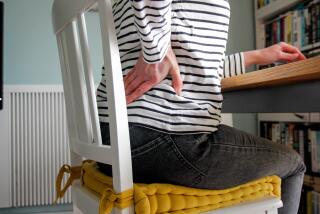Finding the source of that aching back
- Share via
Deducing the source of back pain is a science. It’s just not an exact one.
“If you went to 15 different doctors about your back pain, you’d get 18 different recommendations for treatment,” says Dr. Heidi Prather, associate professor of physical medicine and rehabilitation in the department of orthopedic surgery at Washington University in St. Louis. “That’s because some of them would give you more than one.”
Top-of-the-line diagnostic tools — e.g., MRI, CT scans, X-rays — are excellent at locating possible trouble spots, but, oddly, their findings don’t always match with the symptoms that patients report.
“Sometimes all the problems we see are on one side but the pain is on the other side,” says Dr. Alok Sharan, chief of spinal surgery at Montefiore Medical Center in the Bronx, N.Y. “It doesn’t make sense, but it happens.”
One doctor tells the story of a patient who had two MRIs. The first — taken when the patient was experiencing terrible pain — found nothing amiss. The second — taken later, when her back was feeling hunky-dory — showed a badly ruptured disk.
Stories like that are the likely source of a common mantra among doctors who treat back pain: “Treat the patient, not the images.”
That means relying on old-fashioned, low-tech diagnostic methods. “Figuring out spine pain is the last bastion of the physical exam,” says Dr. Michael Ferrante, director of the UCLA Pain Management Center and professor of clinical anesthesiology and medicine at the David Geffen School of Medicine at UCLA. “You have to put your hands on the patient. It’s the most important thing I do. Most of the fancy technology just corroborates what an exam shows. It doesn’t lead to the answer.”
But physical exams can’t always give all the answers either. Consider this: Disks are located at the front of the spine, while facet joints — which facilitate motion — are at the rear. So if patients have pain when they lean forward, that should indicate a disk problem, while pain when they lean back should mean a facet problem. Right? Not necessarily.
“It’s a nice theory,” says Dr. Sean Mackey, chief of the pain management division at Stanford University. “But it’s not entirely validated.”
Further, a lot of things can go wrong with a back, and as you age, it’s quite likely that more than one of them will go wrong with yours. Many people older than 40 have at least one ruptured disk, Mackey says, and degenerative disk disease can begin to set in at the tender age of 20.
So while back pain is likely, figuring out the cause, or causes, is not a straightforward proposition.





